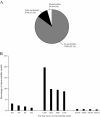Development and validation of microsatellite markers for Brachiaria ruziziensis obtained by partial genome assembly of Illumina single-end reads
- PMID: 23324172
- PMCID: PMC3565986
- DOI: 10.1186/1471-2164-14-17
Development and validation of microsatellite markers for Brachiaria ruziziensis obtained by partial genome assembly of Illumina single-end reads
Abstract
Background: Brachiaria ruziziensis is one of the most important forage species planted in the tropics. The application of genomic tools to aid the selection of superior genotypes can provide support to B. ruziziensis breeding programs. However, there is a complete lack of information about the B. ruziziensis genome. Also, the availability of genomic tools, such as molecular markers, to support B. ruziziensis breeding programs is rather limited. Recently, next-generation sequencing technologies have been applied to generate sequence data for the identification of microsatellite regions and primer design. In this study, we present a first validated set of SSR markers for Brachiaria ruziziensis, selected from a de novo partial genome assembly of single-end Illumina reads.
Results: A total of 85,567 perfect microsatellite loci were detected in contigs with a minimum 10X coverage. We selected a set of 500 microsatellite loci identified in contigs with minimum 100X coverage for primer design and synthesis, and tested a subset of 269 primer pairs, 198 of which were polymorphic on 11 representative B. ruziziensis accessions. Descriptive statistics for these primer pairs are presented, as well as estimates of marker transferability to other relevant brachiaria species. Finally, a set of 11 multiplex panels containing the 30 most informative markers was validated and proposed for B. ruziziensis genetic analysis.
Conclusions: We show that the detection and development of microsatellite markers from genome assembled Illumina single-end DNA sequences is highly efficient. The developed markers are readily suitable for genetic analysis and marker assisted selection of Brachiaria ruziziensis. The use of this approach for microsatellite marker development is promising for species with limited genomic information, whose breeding programs would benefit from the use of genomic tools. To our knowledge, this is the first set of microsatellite markers developed for this important species.
Figures


Similar articles
-
High degree of genetic diversity among genotypes of the forage grass Brachiaria ruziziensis (Poaceae) detected with ISSR markers.Genet Mol Res. 2011 Nov 17;10(4):3530-8. doi: 10.4238/2011.November.17.5. Genet Mol Res. 2011. PMID: 22095482
-
Development of Genomic Microsatellite Markers in Carthamus tinctorius L. (Safflower) Using Next Generation Sequencing and Assessment of Their Cross-Species Transferability and Utility for Diversity Analysis.PLoS One. 2015 Aug 19;10(8):e0135443. doi: 10.1371/journal.pone.0135443. eCollection 2015. PLoS One. 2015. PMID: 26287743 Free PMC article.
-
Microsatellite marker development by partial sequencing of the sour passion fruit genome (Passiflora edulis Sims).BMC Genomics. 2017 Jul 21;18(1):549. doi: 10.1186/s12864-017-3881-5. BMC Genomics. 2017. PMID: 28732469 Free PMC article.
-
Advances in genetics and molecular breeding of three legume crops of semi-arid tropics using next-generation sequencing and high-throughput genotyping technologies.J Biosci. 2012 Nov;37(5):811-20. doi: 10.1007/s12038-012-9228-0. J Biosci. 2012. PMID: 23107917 Review.
-
[Plant Genome Sequencing: Modern Technologies and Novel Opportunities for Breeding].Mol Biol (Mosk). 2022 Jul-Aug;56(4):531-545. doi: 10.31857/S0026898422040048. Mol Biol (Mosk). 2022. PMID: 35964310 Review. Russian.
Cited by
-
Development and characterization of polymorphic genic-SSR markers in Larix kaempferi.Molecules. 2015 Apr 8;20(4):6060-7. doi: 10.3390/molecules20046060. Molecules. 2015. PMID: 25856058 Free PMC article.
-
Genetic diversity of leafy amaranth (Amaranthus tricolor L.) resources in Vietnam.Breed Sci. 2019 Dec;69(4):640-650. doi: 10.1270/jsbbs.19050. Epub 2019 Oct 9. Breed Sci. 2019. PMID: 31988628 Free PMC article.
-
Whole genome shotgun sequences for microsatellite discovery and application in cultivated and wild Macadamia (Proteaceae).Appl Plant Sci. 2014 Mar 31;2(4):apps.1300089. doi: 10.3732/apps.1300089. eCollection 2014 Apr. Appl Plant Sci. 2014. PMID: 25202615 Free PMC article.
-
Microsatellite loci for Urochloa decumbens (Stapf) R.D. Webster and cross-amplification in other Urochloa species.BMC Res Notes. 2016 Mar 10;9:152. doi: 10.1186/s13104-016-1967-9. BMC Res Notes. 2016. PMID: 26964874 Free PMC article.
-
Transcriptome Analysis and Microsatellite Markers Development of a Traditional Chinese Medicinal Herb Halenia elliptica D. Don (Gentianaceae).Evol Bioinform Online. 2018 Jul 25;14:1176934318790263. doi: 10.1177/1176934318790263. eCollection 2018. Evol Bioinform Online. 2018. PMID: 30083050 Free PMC article.
References
-
- de Lima M, Pessoa M, Neves M, de Carvalho E. Segundo inventário brasileiro de emissões e remoções antrópicas de gases de efeito estufa. Ministério da Ciência e Tecnologia, Brasília; 2012. Emissões de metano por fermentação entérica e manejo de dejetos de animais; p. 120.
-
- Barcellos AO, Vilela L, Lupinacci AV. Encontro Nacional do Boi Verde - A Pecuária Sustentável: 2001. Sindicato Rural de Uberlândia, Uberlândia; 2001. Produção animal e pasto: desafios e oportunidades; pp. 29–64.
-
- Barbosa RA. Morte de pastos de braquiárias. Embrapa Gado de Corte, Campo Grande; 2006.
-
- Ishigaki G, Gondo T, Ebina M, Suenaga K, Akashi R. Estimation of genome size in Brachiaria species. Grassl Sci. 2010;56(4):240–242. doi: 10.1111/j.1744-697X.2010.00200.x. - DOI
-
- Billotte N, Lagoda PJL, Risterucci AM, Baurens FC. Microsatellite-enriched libraries: applied methodology for the development of SSR markers in tropical crops. Fruits. 1999;54(4):277–288.
Publication types
MeSH terms
Substances
LinkOut - more resources
Full Text Sources
Other Literature Sources

